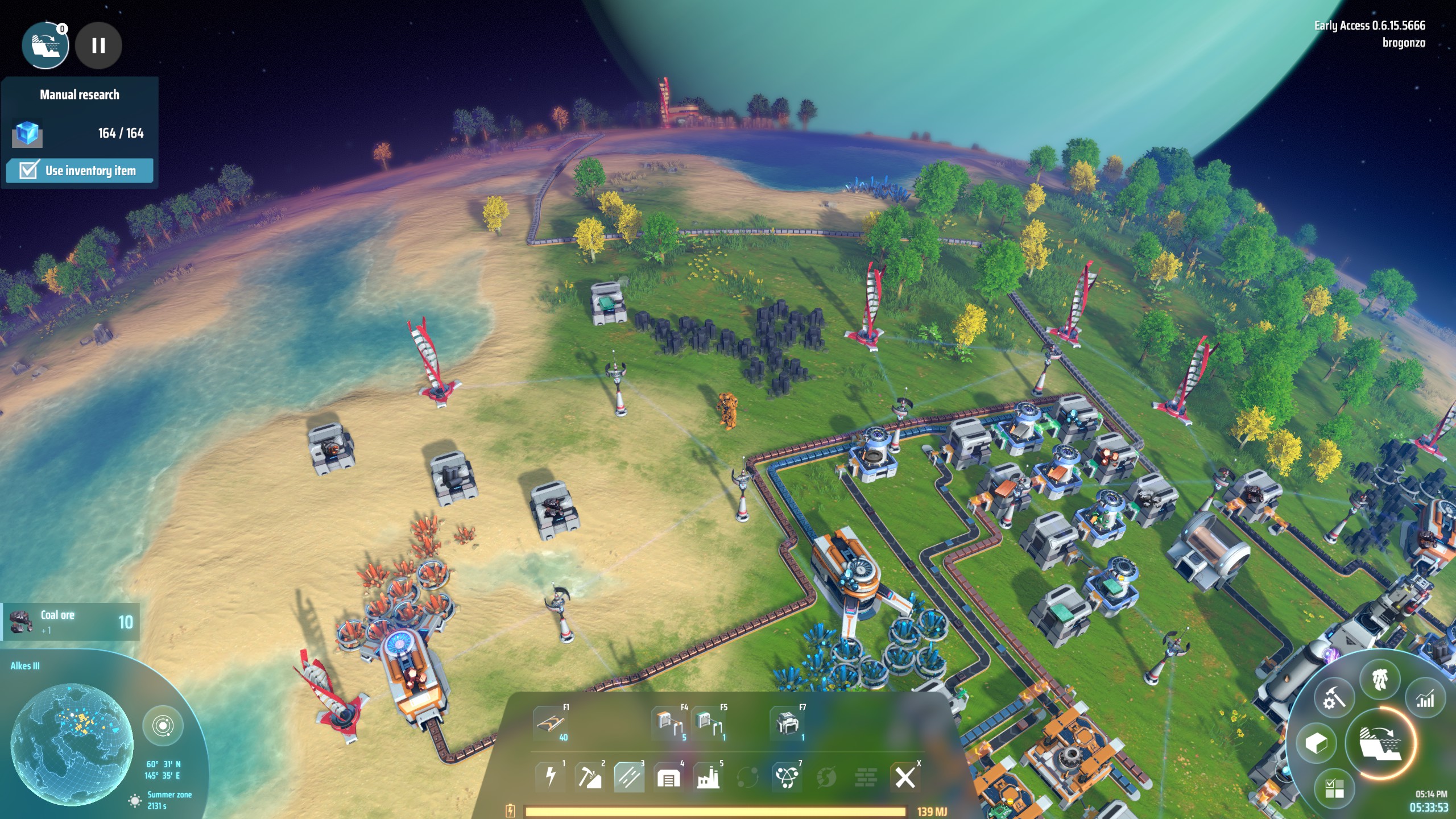Now that 2021 is off to a great start, we can finally hope for humanity’s next step forward. With great advancements in the world of gaming, the month of January proved kinda sparse. We had Bloober Team’s fantastic horror-adventure, The Medium, and the acclaimed Hitman 3. Speaking of Hitman 3, still no word on IO Interactive’s takeback of their original, controversial policy regarding Hitman 1 and 2. Hopefully, PC players won’t have to repurchase those games to unlock the bonus missions after all.
Anyway, we digress. Now that the new month is here, so too come new exciting games and prospects. These past weeks have brought us a great new Steam offering (sorry console players, this is PC exclusive). We’re talking about the massively popular Dyson Sphere Program, a simulation game that puts players in the role of an interstellar resource gatherer.
As the builder of new space colonies, it’s your job to find energy sources, raw materials, and suitable locations for your people. So, it follows that careful planning, strategic knowledge of the game’s mechanics, and tactical know-how prove paramount. Simply put, you need planning, focus, and efficiency if you want your colony to thrive.
All of this can seem almost frighteningly complex at first glance. Truth be told, most great games take a lot of practice and experimenting to figure out. However, we have you covered. The purpose of this Dyson Sphere Program guide isn’t to give you a boring lecture about each and every mechanic and feature the developer, Youthcat, stuffed in. No, we’ll let you figure those for yourself for now, and save you the satisfaction.
Getting settled in when playing Dyson Sphere Project for the first time can seem daunting
The game itself is a whole can of worms, and we mean that in a good way. Youthcat made the wise decision of keeping their title in beta for an extended period of time. This no doubt allowed them and their player base to test out what does and doesn’t work, and optimize the full release accordingly. If only a certain high-profile, controversially panned AAA title had the sense to do that last year, huh?
That said, things remain pleasantly barebones in many cases, while appropriately challenging in others. Many a promising Dyson Sphere Program guide online claims to be able to teach you the fundamentals of the game easily. Our own opinion is that this is a moot point since the game’s tutorial holds your hand for a while then cuts off abruptly. While some believe this to exacerbate a natural learning curve, we feel all a player needs is a few pointers in the right direction. After all, imagine how boring a great strategic game like Civilization VI would become if it came with more comprehensive, slower tutorials.
Right off the bat, you start the game with a plethora of possibilities. While not exactly an infinite, Minecraft type of sandbox, the game still provides a huge expanse to explore. With every direction you take, so too do many options and choices become available. Do you want your power source here, where the upkeep may prove costly but the output strong? Or do you think it a better idea to strip-mine the area for valuable resources, and settle down further away? The choice is yours, but the implications of every move remain complex.
You’ll need a good, dependable guide to speed up your game setup
A poor choice at the start of your playthrough can manifest as a terrible consequence later on. Settling down in a non-sustainable area will mean working hard to keep the colony afloat, and sometimes leading to a losing battle. That’s why we took the liberty of creating our own Dyson Sphere Program guide. With a little bit of inspiration from our winning formula (that we painstakingly managed to discover after countless hours of experimenting), we know you’ll be able to develop a competent and well-established foothold for the rest of your playthrough. What’s more, we bet you that if you follow this guide closely, you can become independent and ready to start soon into loading into the game.
A few disclaimers before we begin, however. For one, everyone’s time taken will vary on several factors. If your PC hardware has trouble running the game, expect longer load times. In addition, some players need a little more time than others to execute all of the steps mentioned; call it a longer reaction time. Lastly, our guide is specifically set to cover the game’s meta at the time of release. Note that Youthcat will and probably has released several updates and balances to keep the game optimized and increase longevity. So, some items, options, and mechanics are indeed subject to change in your own game.
The first step – load in with an advantageous initial world seed, and get the essentials down
Like Minecraft, the worlds in Dyson Sphere Program come procedurally generated. That means the game automatically makes a brand new universe to explore in every playthrough. Because that introduces a lot of confounding variables (not all procedurally generated worlds are equal), we recommend sticking to a tried-and-tested world seed. This seed is essentially a blueprint of the world you’ll play in, and will determine the locations and quantities of resources. Don’t feel bad for using a more manageable seed – all the pros who speedrun games do it, and it just helps you scratch off one less thing to worry about when starting your playthrough.
In our experience, one of the best community seeds to use is 41009301. Use this code to load into the map, and let’s move onto your essential objectives. The two main steps to start off with include deconstructing the landing capsule, then using the parts obtained to craft specific items. Start off this process, then open the T tab to start constructing the following techs in this order: Electromagnetism, Automatic Metallurgy, Basic Logistics System, Basic Assembling Processes and the Electromagnetism Matrix.
Use these Techs to cater to your fuel requirements. Create Hydrogen fuel rods in the Fuel Chamber, then wait till you receive your reward: the first Mining Machine. When placed on iron ore, you can extract upto 6 nodes of Iron. Then, use your remaining resources to craft and place a Tesla Tower and a Wind Turbine accordingly. This should help set up your very first power source!

Repeat the above steps to create Gears, Circuits and Magnetic Coils. Use these to construct the 4 other Techs we mentioned. These will help you sustainably continue mining for Stone and Copper. This process is critical, but if you do it correctly you can move onto the next goal.
Craft Mining Machines on the new Copper, Iron and Magnet Belts
The next step will see you connect your ore veins together for greater efficiency. You’ll want to construct at least 6 Mining Machines, 9 Turbines and several Tesla Towers, and then juke the system for greatest turn over. That means placing not more than 1 Mining Machine on Stone or Copper, and 2 for every patch of Iron or Coal. This will make it so your only concern for now is generating adequate power levels. Keep an eye on those Tesla Towers and Wind Turbines, so that they have full operational capacity.
Now, you’ll need to set up conveyor belts accordingly, to make sure all the ores reach smelters. Construct smelters and sorters, enough to build a Smelting Station.

Use the Iron belt to set up a channel of output. The destination? Right into a group of Assemblers, that you can construct using all of your accumulated resources. We recommend investing your construction into Gears, which will save time later on as they prove super useful.
Repeat the above steps for Copper and Magnets, which will also need their own separate conveyer belt complexes. This time around, it pays to learn this process by heart because it essentially becomes your de facto priority whenever you reach a rich ore vein. Remember to build extra Wind Turbines to keep energy levels from tanking.
Develop an automated Magnetic Coils and Circuits facility, and establish a Blue Science Research Factory
The main principle we try to highlight in our Dyson Sphere Program guide is knowing when to move onto the next settlement. Sure, you could pour in hours into making your factories bigger and better, but once your ores get depleted it becomes a point of diminishing returns. Instead, the main focus of the game is to branch out, and expand operations indefinitely to maximize your productivity. Therefore, you’ll need lots of Matrix cubes, which help create new Techs.
Matrix cubes come from Matrix Labs, which collectively make up a Blue Science Research Factory. Since each lab requires 2 Assemblers for coils and circuits, you’ll need to calculate your number of labs accordingly. We would recommend at least 10, just to keep your factory running at maximum efficiency. If you have any remaining Assembler machines, know that their products go straight into your storage for later. That means even if you do not require any pieces from them at the time, you can profit off of them in other areas. Don’t you just love space capitalism?
The Blue Science factory will take some efficient setups and finesse to get right
At any rate, the focus should shift onto establishing your Research Facility. As we highlighted before, developing new Techs is nigh on imperative in Dyson Sphere Program. You can still research new objects and mechanics in the background, but those Matrix cubes will need dedicated Matrix labs. At this point, we suggest investing in the improved, Mk 2 variants of Sorters. These will help increase the tile width of your Assembler channels, preventing a shortage of distribution. Now, we can build and start to place the new Matrix labs as we like.
The best way to save time with these is to stack the Matrix Labs vertically. Try to follow an organized pattern, such as a row of 3 labs under 2 stacked ones. Then, ensure that your conveyer belts reach the inputs to the labs properly. That means checking on your Magnetic Coil and Circuit belts, and tailoring them to reach the bottom labs first. It is best to use at least two Sorter per belt channel, at least on the outer side, so that the extra travel time of the components doesn’t slow down progress. Now that you’re all set to begin blue Matrix cube production, it is vital to check up on your power grid allocation.
Build as many Tesla Towers as necessary, and look at your Matrix lab assortment once more. Since you’ll be generating lots of power here, it follows that more labs will become practical to draw the energy. Therefore, a smart strategy, and an highly organized one, will be to place a row of 3 Matrix labs parallel to your original stack. These should reach the vertical 3 stack limit for best results. This way, power loads will become efficiently distributed, resource conveyer belts shared and Sorters more easily accessible.
The final steps in the Dyson Sphere Program guide – accumulate resources, then set off for new settlements
Now that you have your Blue Science Research Factory set up, it’s time to start cube production. This will allow you to easily take your strategy to the next level. Now, you can progress from the initial struggle to gain a foothold, to a well-established setup. The influx of raw materials and cubes should prove useful. After all, you can now Upgrade and create new Mechs, which become invaluable to your expansions into new colonies.
However, keep in mind the game has only just begun. As you know grow familiar with the general checklist of priorities, you can confidently chart out prospective areas of interest. No longer should you blindly and haphazardly start developing power and mining facilities: now, you’ll know how to strategize and plan accordingly. Just keep in mind that if you do not maintain your established factory complexes, you could potentially bleed resources keeping the ecosystem afloat. That would mean losing everything, especially the time you saved using our Dyson Sphere Program guide.
For more on Dyson Sphere Program, useful guides, bug fixes, and news stay tuned!


